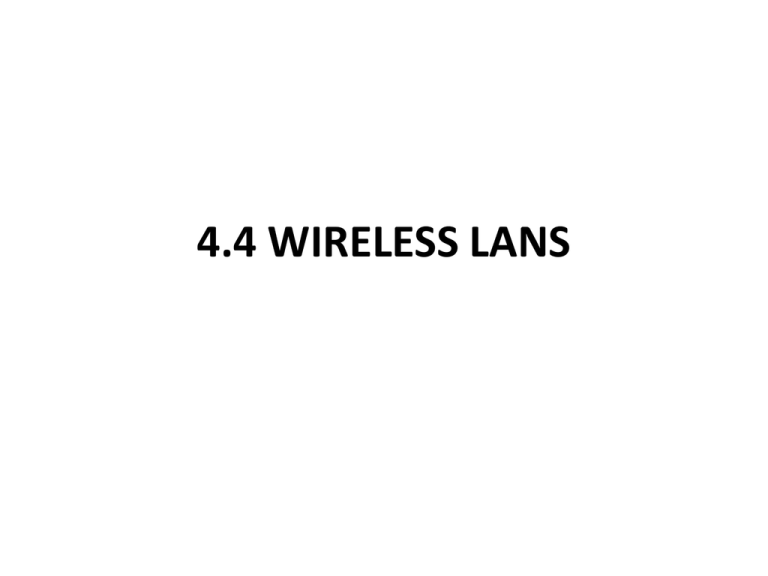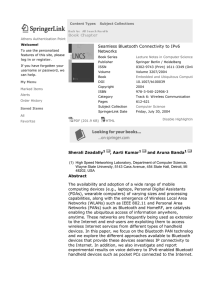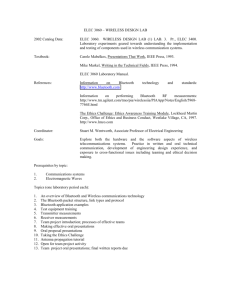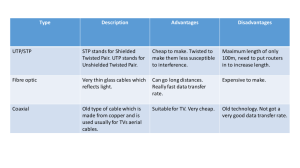4.4 WIRELESS LANS
advertisement

4.4 WIRELESS LANS 4.4.1 The 802.11 Architecture • WIRELESS LANS: – informal name: Wifi – IEEE group number : 802.11 • The 802.11 architecture – infrastructure mode: each client is connected with an AP (Access Point) – ad hoc mode: no access point • Since there is no Internet access, ad hoc networks are not very popular. 2 infrastructure mode 3 ad hoc mode 4 4.4.1 The 802.11 Protocol Stack • The data link layer: – the MAC (Medium Access Control) sublayer: determines how the channel is allocated, that is, who gets to transmit next. – the LLC (Logical Link Control) sublayer: hide the differences between the different network technologies 5 4.4.1 The 802.11 Protocol Stack (Cont.) • The physical layer(deals with transmission techniques): – Infrared – frequency hopping – spread spectrum – OFDM (Orthogonal Frequency Division Multiplexing) scheme • All above transmission techniques generally use the unlicensed frequency Band 2.4 GHz 6 4.4.1 The 802.11 Protocol Stack 7 4.4.5 Services • The association service : to connect mobile stations to APs. • The Reassociation service : lets a station change its preferred AP • The Authentication service : database to determine if the station is allowed to access the network. – The recommended scheme, called WPA2 (WiFi Protected Access 2) 8 4.4.5 Services • The integration service : handles any translation that is needed for a frame to be sent outside the 802.11 LAN, or to arrive from outside the 802.11 LAN. • Data delivery service: lets stations transmit and receive data • The privacy service : manages the details of encryption and decryption • A companion service : provides higher-layer timer synchronization 9 4.5 BROADBAND WIRELESS broadband • broadband refers to telecommunication in which a wide bandwidth of frequencies that are available to transmit information. • Broadband can allow remote stations(devices) to connect to a central station at high speeds. 11 Example on Broad Band Technologies • Telephone System Broad Band Technologies – Plain old telephone service (POTS) – Integrated Services for Digital Network (ISDN) – Digital subscriber line (DSL) • Cable Television Technology • Satellites Technology • Cellular Communication Technology – (BroadBand Wireless) 12 4.5 BROADBAND WIRELESS • informal name: WiMax • IEEE group number : 802.16 • Comparison of 802.16 with 802.11 (similarities): – 802.11, 802.16 is based on OFDM technology – 802.11, 802.16 transmission medium is the radio waves • Comparison of 802.16 with 802.11 (differences) – 802.16 base stations uses more power and better antennas – 802.16 base stations perform more processing to handle errors and weaker signals over larger distances. – 802.16 base station carefully schedules transmissions for each subscriber 13 4.5.2 The 802.16 Architecture 14 4.5.2 The 802.16 Protocol Stack 15 4.5.2 The 802.16 Protocol Stack • The physical layer ( deals with transmission techniques) • • The data link layer: – Security layer: deals with privacy and security – MAC common layer: determines how the channel is allocated, that is, who gets to transmit next. – The service-specific convergence sublayer (like LLC) : hide the differences between the different network technologies 16 4.6 BLUETOOTH Wireless Networks PAN 802.15.x 10m LAN 802.11 100m MAN 802.16 2-6km WAN 2G, 3G 2km/link national areas Overview of wireless networks 18 Bluetooth • IEEE group number of Wireless PAN (Personal Area Network including Bluetooth) : 802.15 • The key features of Bluetooth technology are: – – – – Short Range and Small Networks Robustness (high levels of security) low power, and low cost. • Bluetooth uses the unlicensed 2.4 GHz ISM band 19 What does Bluetooth do for you? Landline Cable Replacement Data/Voice Access Points Personal Ad-hoc Networks 20 4.6.1 Bluetooth Architecture • The basic unit of a Bluetooth system is a piconet; • A Piconet: it consists of a master node (for synchronization purposes) and up to seven active slave nodes nodes within a distance of 10 meters. • there can be up to 255 parked nodes 21 4.6.1 Bluetooth Architecture (cont.) • A Scatternet : is interconnected collection of piconets. • Multiple piconets can be connected via a bridge slave node • The reason for the master/slave design is to facilitate the implementation of cheap complete Bluetooth chips • direct slave-slave communication is not possible: the slaves just do whatever the master tells them to do. 22 4.6.1 Bluetooth Architecture 23





